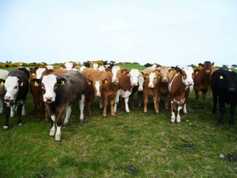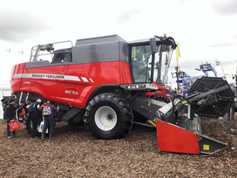Many farmers are under serious pressure to source additional forage to see them comfortably through the remainder of winter and early spring.Farms in the traditionally drier regions of the country may well be able to get stock back to grass in February, but caution should be aired against turning stock out too early.
Many farmers are under serious pressure to source additional forage to see them comfortably through the remainder of winter and early spring.
Farms in the traditionally drier regions of the country may well be able to get stock back to grass in February, but caution should be aired against turning stock out too early.
If grass covers across the farm are not sufficient for numbers grazing, cattle will not have enough grass in the second rotation and will require supplementation with either concentrates or bales. In some cases, re-housing may be required.
Likewise, in areas where land is heavier and wetter, cows may struggle to get back to grass before late March if forage stocks run out. These farms should be budgeting to have silage in store to feed cattle until April or later.
A point to note is that even if early, favourable spring weather conditions are realised, ground that was badly damaged in 2012 will not respond in terms of grass growth to the weather conditions.
Land that was badly trampled will be compacted and will need to be remedied before it comes back into full production again. Whether this is through sub-soiling, ploughing and reseeding, or a drainage project, do not gamble solely on a good spring to solve all fodder issues.
While an early spring will be a major help, and would be greatly welcomed, it is advisable to take steps immediately to alleviate any feed crisis that could potentially be building up. Options that should be considered include:
Culling barren or poor performing cows.Move finishing cattle onto ad-lib meals.Increase concentrates in diet.Substitute silage with alternative feeds.Purchase additional forage. Feeding cull cows
There is little point holding unproductive stock in the hope for a higher sale price, especially if forage is tight. With spring cows weaned and the breeding season finishing for autumn calving herds, now is a good time to cull unproductive or poor breeding cows.
These animals will respond to high energy concentrate rations and finish in a period of five to six weeks, depending on age, breed and body condition at the beginning of the feeding period.
Where good quality silage is available (70+ DMD), feeding 4kg of a simple barley, distillers and beet pulp mix will suffice. This ration is being bought at €290/tonne and, taking silage at €35/tonne, the cow would have a daily feed cost of €2.11/day, assuming the cow eats 26kg of 30% dry matter silage.
Where silage quality is low or in short supply, cows are better switched onto ad-lib meals and straw. Typical feed costs should be around €2.50 to €3.50/day, depending on cow intakes.
With continental suckler cows, it is basically taking money out of your pocket to sell under-fleshed cows. Feeding meals for a period of 40 to 50 days will bring cows up a grade and increase fat score. Continental suckler cows will be capable of a daily gain of up to 1kg liveweight/day.
For example, take a 350kg cow carcase grading O+ 2= commanding a price/kg of €3.50 and a cow that was fed for 50 days. It will have a 375kg carcase grading R=3= commanding a price of €3.80/kg. The difference in carcase value is €200.
Assuming the cow was ad-lib fed on 10kg concentrates and 2kg of straw, feed cost during the finishing period is €145 for the concentrates only. There is a potential saving of 1.3 tonnes of silage moving the cow onto ad lib meal during this period.
Move finishing cattle onto ad-lib meals
By now, finishing cattle will be on a high level of concentrates. A 600kg steer will eat approximately 12kg DM/day (2% of its body weight). Therefore, a steer eating 8kg of meal will eat approximately 15kg to 16kg of silage at 25% dry matter. It will not be capable of eating enough silage if dry matter is any lower.
Including 1kg of straw in the diet will reduce daily consumption of silage to 5kg. If silage quality is below average, steers and bulls will be better off on an ad-lib diet of concentrates.
As with the cull cows, the energy content in the diet is more important than the level of protein in the final 60 days before slaughtering.
A simple three way blend purchased at €290/tonne and straw at €80/tonne will mean a daily feed cost for a finishing steer is approximately €2.45/day, eating 10kg of concentrates plus 2kg of straw.
Taking a U3 beef price of €4.40/kg and a kill out of 58%, the carcase is generating a daily income of €2.55/day.
It is vital that cattle are sold as soon as they reach market spec. Heifers are less suited to this option as they will go overfat too quickly.
Increase concentrates
Depending on silage quality, 1kg of concentrates will replace 6kg of silage. Taking silage at €35/tonne means that 6kg of concentrates will cost €0.21, while 1kg of concentrates will cost €0.29 to €0.35 depending on ration cost.
While there is a net increase in daily feed cost of €0.08 to €0.14/day, there will be a performance benefit. An increase of 0.1kg/day is worth €0.21 at a live trade price of €2.10/kg.
Increasing concentrates should be primarily offered to calved cows or weanlings that will not get to grass before mid-March. Cattle that go to grass early can avail of compensatory growth, whereas cattle being turned out later need a heavier turnout weight as they have a shorter window of opportunity for compensatory growth.
If selling cattle through the live ring, the extra concentrates will ensure that the animal is better fleshed and command a better price due to heavier sale weight.
Substitute with alternative feeds
When purchasing alternative feeds, it is important to remember that the purchase price is relative to the current price of barley. Feeds must be compared on a dry matter basis.
When purchasing straights, they should be split into two groups; namely, energy sources and protein sources. While energy sources are compared to dried barley, protein sources are compared to soya.
Table 1 outlines the relative feed value of straights that provide energy in cattle diets.

Table 2 outlines the relative feed value of protein source straights compared to soya.

Relative feed price to barley means how much is the feed worth, for example, if maize is purchased for €300/tonne, it is value for money, but at €320/tonne it is too expensive if barley is €270/tonne.
Table 3 contains a rule of thumb guideline for replacing 10kg of silage in cattle diets. It should be noted that when silage is replaced with straw or haylage, mineral supplementation becomes important. The maximum feed guideline is also included in the table.

Purchase additional forage
Along with what price will beef be this spring, what price is silage worth seems to come up in most conversations at present. Unless you have a forage analysis, it is impossible to answer.
Even if the silage is analysed, and a value can be placed on it, this does not mean that you will get to buy it at this price.
Competition from other farmers who require feed will mean that a bidding war will be the likely outcome, with the seller the winner.
However, you should bear in mind at what price do concentrates become better value than silage.
Silage analysis from the BETTER Farm programme had a typical feed analysis of 22% dry matter and 10-11% protein content. DMD average 67.
Taking barley at €270/tonne, purchasing silage of similar quality would cost €40/tonne before concentrates become better value.
Whichever option you decide to follow to stretch silage supplies this winter, the earlier you act the better.
Conserving silage now rather than waiting until March when the back wall of the silo is within reach gives a greater range of options.
Waiting until March before increasing concentrates will be a waste of time as fodder supplies will only be stretched by a week at best.
Likewise, trying to buy silage in March will be a difficult task, both in terms of getting value for money and getting the required quantity. In addition, be careful of forage quality when buying.
If silage is poorly preserved, you should be careful when feeding. Mouldy, spoiled silage should not be fed to dry cows as there is an abortion risk.
As mentioned earlier, take small steps now to avoid a build up of feed problems that will be realised in the middle of calving.
Key points
Carry out a fodder budget to estimate silage stocks.Feed cows for 40 to 50 days to ensure they are properly fleshed.Move finishing steers onto ad-lib meals in final 60 days if silage quality is average or poor.Increase concentrates to cattle that will respond best or will be sold live.Purchased feed should be compared on a dry matter basis to either barley or soya.Act now to avoid problems later. Read more
Soil fertility holds key to reseeding success





SHARING OPTIONS: